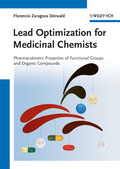Lead Optimization for Medicinal Chemists
Pharmacokinetic Properties of Functional Groups and Organic Compounds

1. Auflage April 2012
XVI, 606 Seiten, Hardcover
Handbuch/Nachschlagewerk
Jetzt kaufen
Preis: 175,00 €
Preis inkl. MwSt, zzgl. Versand
Euro-Preise für Wiley-VCH- und Ernst & Sohn-Titel sind nur für Deutschland gültig. In EU-Ländern gilt die lokale Mehrwertsteuer. Portokosten werden berechnet.
Small structural modifications can significantly affect the pharmacokinetic properties of drug candidates. This book, written by a medicinal chemist for medicinal chemists, is a comprehensive guide to the pharmacokinetic impact of functional groups, the pharmacokinetic optimization of drug leads, and an exhaustive collection of pharmacokinetic data, arranged according to the structure of the drug, not its target or indication. The historical origins of most drug classes and general aspects of modern drug discovery and development are also discussed.
The index contains all the drug names and synonyms to facilitate the location of any drug or functional group in the book.
This compact working guide provides a wealth of information on the ways small structural modifications affect the pharmacokinetic properties of organic compounds, and offers plentiful, fact-based inspiration for the development of new drugs. This book is mainly aimed at medicinal chemists, but may also be of interest to graduate students in chemical or pharmaceutical sciences, preparing themselves for a job in the pharmaceutical industry, and to healthcare professionals in need of pharmacokinetic data.
THE DRUG DISCOVERY PROCESS
Pharmacokinetics - Structure Relationship
The Future of Small-Molecule Drugs
LEAD OPTIMIZATION
What Limits/Reduces Oral Bioavailability?
What Limits/Reduces Plasma Half-Life?
How to Improve bbb-Penetration?
How to Avoid CYP Inhibition/Induction?
How to Avoid Interaction with the HumanEther-'a-go-go-Related Gene (hERG)?
How to Prevent Toxicity?
Examples of PK-Optimization in Animals
PART II: The Pharmacokinetic Properties of Compound Classes
ALKANES
Metabolism
ALKENES AND ALKYNES
Metabolism
ARENES
Metabolism
HALIDES
Fluorine
Chlorine
Bromine
Iodine
Alkylating Agents
AZIDES
NITRO COMPOUNDS
Metabolism
AZO COMPOUNDS
TRIAZENES
NITRATES AND NITRITES
N-NITROSO COMPOUNDS
N-OXIDES
ALCOHOLS
Metabolism
PHENOLS
ETHERS
Metabolism
EPOXIDES
PEROXIDES
THIOLS
THIOETHERS
Metabolism
SULFOXIDES
SULFONES
ALIPHATIC AMINES
Basicity
Metabolism
Rates of N-Dealkylation
QUATERNARY AMMONIUM SALTS
AMIDINES
GUANIDINES, ACYLGUANIDINES, AND BIGUANIDES
Acylguanidines
Biguanides
ANILINES
Metabolism
HYDRAZINES, ACYLHYDRAZINES, AND HYDRAZONES
ALDEHYDES
KETONES
CARBOXYLIC ACIDS
Metabolism
Bioisosteres of Carboxylic Acids
Amino Carboxylic Acids, N-Acyl Amino Acids, and Related Compounds
CARBOXYLIC ESTERS
AMIDES
LACTAMS AND IMIDES
Pyrazolone Antipyretics
Five-Membered Lactams as Nootropics
NITRILES
CARBONATES
CARBAMATES
Carbamates as Hypnotics
UREAS
THIOCARBONYL COMPOUNDS
SULFONIC ACIDS
SULFONIC ESTERS
SULFATES AND SULFAMIC ACIDS
PHOSPHONIC ACIDS
PHOSPHORIC ACID DERIVATIVES
N-(AMINOALKYL)BENZAMIDES, -BENZOATES, AND RELATED COMPOUNDS
ARYLALKYLAMINES
Antihistaminics: History
PHENETHYLAMINES (2-PHENYLETHYLAMINES)
Biological Activity of Phenethylamines
Metabolism
Tetrahydroisochinolines and Related Compounds
AMINOALKYLINDOLES AND INDOLE ALKALOIDS
PHENOTHIAZINES
Metabolism
DIBENZAZEPINES AND RELATED TRICYCLIC COMPOUNDS
3-ARYLOXY-2-HYDROXYPROPYLAMINES (B-ADRENERGIC ANTAGONISTS; 'B-BLOCKERS')
Metabolism
OPIATES
N-(CARBOXYALKYL)-a-AMINO ACID AMIDES (PRILS)
ANILIDES AND AMIDES OF GLYCINE
PEPTIDES, PEPTIDOMIMETICS, AND RELATED OLIGOAMIDES
Peptidomimetics
Thrombin Inhibitors and Related Compounds
OLIGOARYLAMINES, OLIGOARYLAMIDES, OLIGOARYLCARBAMATES, AND OLIGOARYLUREAS
IMIDAZOLES
TRIAZOLES
PYRIDINES, PYRIMIDINES, AND RELATED COMPOUNDS
Proton Pump Inhibitors
QUINOLINES
Tecans
Quinazolines
NUCLEOSIDE ANALOGS
DIHYDROPYRIDINES
ARENESULFONAMIDES
Antibacterials
Diuretics
SULFONYLUREAS
BENZODIAZEPINES
STEROIDS
ANTHRACYCLINES
ARYLACETIC, BENZOIC, AND RELATED CARBOXYLIC ACIDS (NSAIDS)
Salicylates
QUINOLONECARBOXYLIC ACIDS (GYRASE INHIBITORS)
B-LACTAMS
Cephalosporins
PROSTAGLANDIN ANALOGS
SARTANS
STATINS
FOLIC ACID ANALOGS (ANTIFOLATES)
TAXANES
MACROCYCLIC COMPOUNDS


